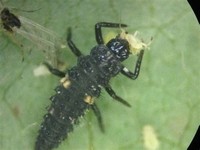Facts about Aphids

Aphids are known for having unusual reproductive adaptations.

The aphids sometimes induce the formation of galls, proliferations and modifications of plant tissues that protect the aphids.

Some species of cabbage aphids (like Brevicoryne brassicae) reproduce rapidly during the summer.

Ants protect the aphids from weather conditions and enemies and transport them to plants for feeding; in turn, the ants obtain honeydew from the aphids.

Many aphids are host to endosymbiont bacteria, Buchnera, which live in specialized cells called bacteriocytes inside the aphid.

Some species of ants "farm" aphids, protecting them on the plant they eat, and eating the honeydew that the aphids secrete.

Aphids are distributed worldwide, but they are most common in temperate zones.

Aphids comprise the Aphidoidea superfamily, with typical aphids in the Aphididae family.

Some aphid infestations cause leaf curl, whereby the feeding of a colony of aphids on the underside of a lead can cause a downward curl.

Aphids probably first appeared around 280 million years ago, in the Carboniferous period.

Some species of ants have a mutually beneficial relationship (mutualism) with aphids in order to "milk" the aphids for honeydew, a sweet substance secreted by the aphids and prized as food by the ants.

Aphidoidea is classified within Hemiptera, an order of insects, comprising around 80,000 species of cicadas, aphids, planthoppers, shield bugs, and others, collectively known as the "true bugs."

Some larvae of the Hymenoptera order (ants, bees, and wasps) can appear like the caterpillars of the lepidoptera.

Aphids tend to have soft bodies with long, thin legs, two-jointed, two-clawed tarsi, and usually a pair of cornicles—abdominal tubes through which a waxy secretion is exuded.

Consisting of incompletely digested but concentrated plant sap, aphid honeydew is rich in carbohydrates, a product of the aphids ingesting an excess of the sap.

Some aphids also provide habitat for endosymbiotic bacteria that synthesize some essential amino acids absent from the aphids' diet.

An underlying harmony in nature is seen in some of the symbiotic relationships in which aphids are involved.

Important natural enemies of aphids include the predatory ladybirds/ladybugs/ladybeetles (Coleoptera: Coccinellidae), hoverfly larvae (Diptera: Syrphidae), and lacewings (Neuroptera: Chrysopidae), and entomopathogenic fungi like Lecanicillium lecanii and the Entomophthorales.

Similarly to related families, aphids passively feed on sap from phloem vessels in plants.

Aphids typically live from 20-40 days and thus undergo multiple parthenogenetic, viviparous generations each summer.

Aphids have two compound eyes and two ocular tubercles made up of three lenses, each of which is located behind and above the compound eyes.

Aphids used chemicals to induce the formation of galls, proliferations, and modifications of plant tissues.

When host plant quality becomes poor or is crowded, female aphids will produce winged offspring that can disperse to other food sources.

Aphids have been known to have what is called telescoping generations.

The aphids will overwinter as eggs and hatch out as females in the following spring.


